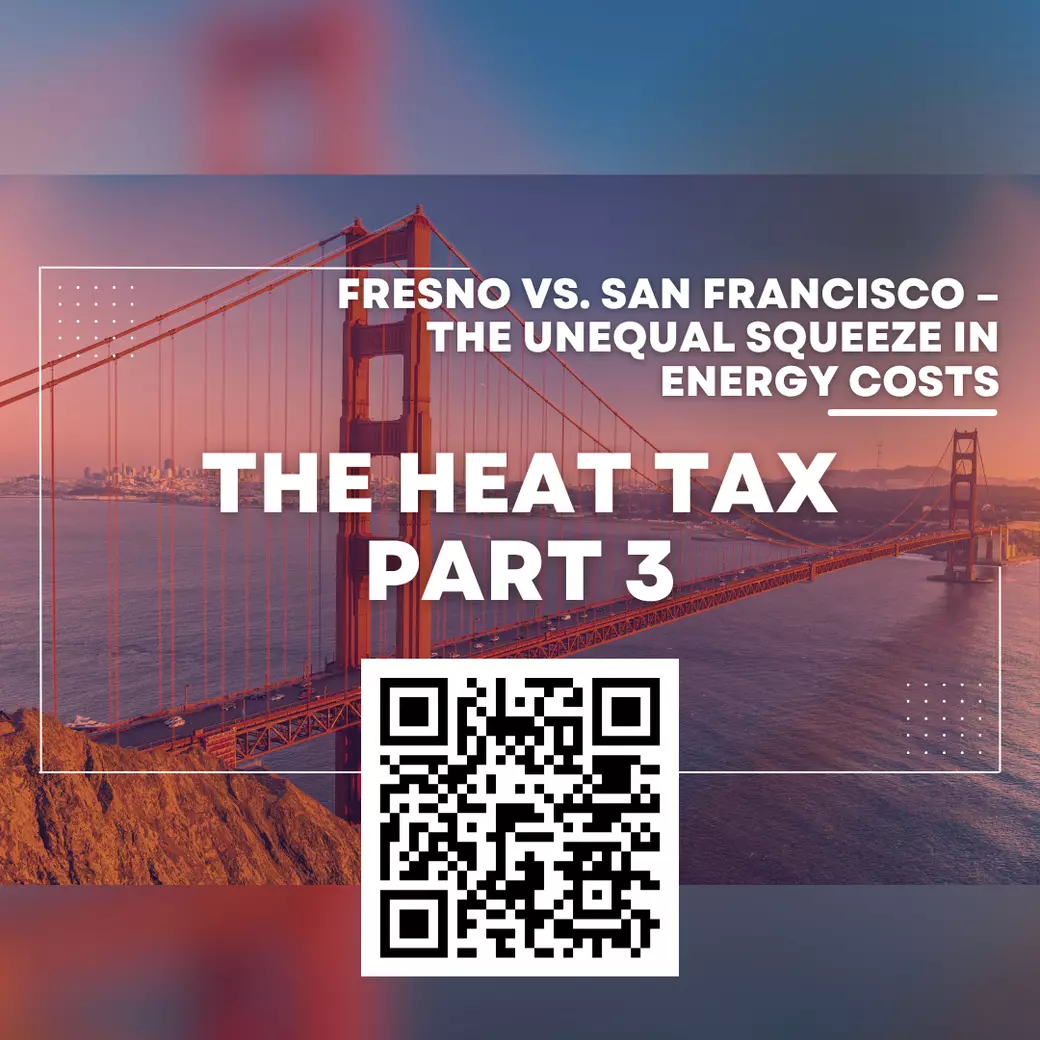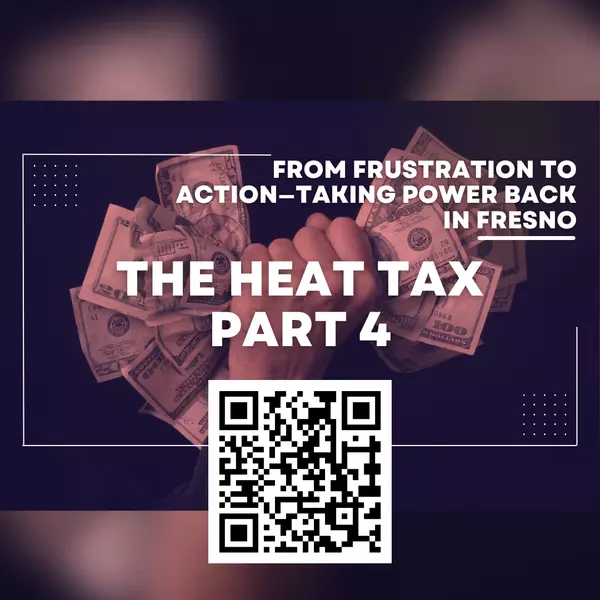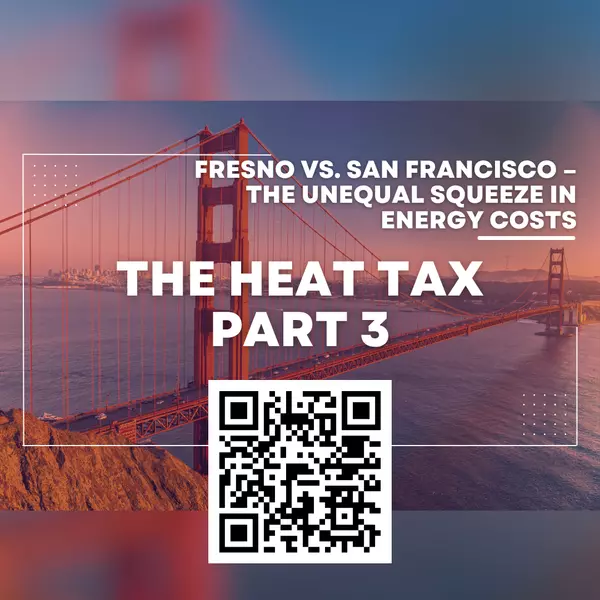The Heat Tax Part 3: Fresno vs. San Francisco – The Unequal Squeeze in Energy Costs

Fresno families know the sting of sky-high electric bills all too well – and it’s not just because of the summer heat. It’s also a story of economic inequality. Compared to wealthier coastal cities like San Francisco, households in Fresno are paying a disproportionate share of their incomes just to keep the lights on and the A/C running. San Francisco’s median household income (around $141,000) is roughly double that of Fresno (about $72,000), yet both areas are served by the same utility, PG&E, at the same baseline electric rates. The difference? Fresno’s scorching climate forces far higher energy use, and those bills take a much bigger bite out of a Central Valley budget than they would in the Bay Area. It’s as if Fresno homeowners are paying a “heat tax” – one that wealthier city dwellers barely feel, but that can buckle a family’s monthly finances in the Valley.
Consider this: a typical Fresno household spends around $3,123 per year (about $260/month) on electricity – the highest in the entire nation. In cooler San Francisco, many homes get by with little or no air conditioning, keeping electric bills relatively low. And of course, a $260 utility bill is a far smaller burden in a city where incomes are six-figures than in a place where many families earn a fraction of that. In effect, energy costs are squeezing Fresno’s budgets much harder than those in wealthier cities. Local officials aren’t surprised: “It’s disappointing but it’s not a surprise,” Fresno’s Mayor Jerry Dyer said upon learning his city had the highest power bills in the U.S. “People just want hope. They can’t continue to see increases in their PG&E bill every year.”
Bay Area Salaries on Fresno’s Dime? PG&E’s Pay Disparities
One hidden factor behind high bills is something most customers never think about: PG&E’s payroll. The utility’s workforce is largely based in high-cost regions like the Bay Area, which means PG&E pays Bay Area–level salaries – and those costs are baked into everyone’s rates. In fact, the median PG&E employee earns about $132,000 a year. That’s more than the median household income in the Bay Area itself, and roughly double what a typical Fresno household earns.
From engineers to lineworkers, PG&E employees generally enjoy pay and benefits befitting the expensive regions where many of them live. Fresno customers, however, don’t get a discount for living in a cheaper area – they pay the same rates per kilowatt-hour as someone in San Francisco or San Jose. This means a family in Fresno making $70k is indirectly subsidizing utility salaries calibrated for a $130k+ lifestyle.
And it’s not just the rank-and-file. PG&E’s top executives also take home eye-popping compensation. CEO Patti Poppe received $51.2 million in 2021 – an astronomical payday over 190 times the average PG&E employee’s salary. Most of that came as stock awards and bonuses, even as regular folks struggled with soaring energy bills. For Fresno families choosing between paying PG&E and buying groceries, it’s hard to stomach news that the utility can lavish tens of millions on executives yet still claim it needs more revenue. The sense of unfairness is palpable: why should some of the state’s poorest metro areas help foot the bill for some of its highest salaries?
Regulators and Rate Hikes: What the CPUC Keeps Approving
If you’re wondering “How can PG&E keep raising our rates?”, the answer lies with California’s regulator, the CPUC (California Public Utilities Commission). This five-member commission (appointed by the governor) must approve major rate increases – and in recent years they’ve signed off on quite a few. In fact, PG&E raised rates six times in 2024 alone, contributing to California having some of the highest electricity rates in the country. Each increase made your bill a little bigger, and each was authorized by the CPUC.
Why does the CPUC keep greenlighting higher charges? PG&E points to huge costs it must shoulder for safety and infrastructure. In a response to lawmakers, the CPUC cited wildfire risk reduction and solar program costs as “the largest contributors” to recent rate hikes. In other words, PG&E has argued – and regulators concur – that billions need to be spent upgrading lines, trimming trees, preventing fires, and even covering subsidy programs like rooftop solar credits. Those expenditures get passed directly to customers.
Still, many ask: couldn’t these upgrades be done more efficiently, without so many rate hikes? Critics accuse the CPUC of too often accepting PG&E’s proposals at face value instead of pushing back. Notably, not one of the CPUC’s commissioners is from the Central Valley. Some wonder if that lack of local perspective has made the pain less visible to decision-makers. When no one on the commission shares your community’s struggles, it’s easier for them to okay yet another increase.
In late 2023, the CPUC approved another massive round of rate hikes to fund PG&E’s wildfire prevention projects – an estimated $6 billion to be collected from customers. That decision alone added about $30 more per month to the average household’s bill. PG&E had asked for even more. Regulators insist these are necessary investments. But in places like Fresno, where the fire risk is moderate and incomes are low, many wonder: are we paying more to fix problems we didn’t create?
Wildfire Mitigation: Central Valley Paying for Others’ Flames
That brings us to the wildfire issue. Nobody denies that massive wildfires have ravaged California and that PG&E’s equipment has been at fault in several tragic blazes. The real question is who shoulders the costs of preventing and dealing with those fires.
Increasingly, the answer has been: everyone. PG&E socializes its wildfire mitigation expenses across all 16 million customers. So even if you live in an urban neighborhood far from any forest, a chunk of your bill goes toward things like tree clearance in the Sierra and undergrounding lines in tinder-dry canyons.
For Fresno residents, this can sting. Many of the highest-risk fire areas are not in the Central Valley floor – they’re in the wooded mountains and rural expanses of Northern California. But as part of PG&E’s vast territory, we’re helping pay for the fallout.
When PG&E sparked the devastating Dixie Fire in 2021, it turned around and sought an 18% rate hike to cover the damages. That fire leveled entire towns hundreds of miles from Fresno, yet every PG&E customer saw their bills go up. Similarly, the push to bury thousands of miles of lines (a very expensive but effective fire prevention strategy) means a Fresno family might be financing fireproofing in distant mountain communities.
The approach has been “spread the pain broadly” – but in a region where the pain is already deep, that strategy feels flawed.
Profits Rising as Bills Soar: Where’s the Fairness?
PG&E’s residential electric rates have more than doubled over the past decade – a 110% increase – with over half of that spike coming in just the last three years. For families in Fresno, these relentless hikes have hit especially hard – Mayor Jerry Dyer notes that local electricity rates jumped about 56% in three years, even as PG&E’s profits surged roughly 35% during the same period. And this is in a community where roughly one in four families lives below the poverty line, making those triple-digit summer power bills feel like a punishing “heat tax” on the city’s most vulnerable households.
In fact, 2024 was a banner year for PG&E’s investors, not its customers. The company reportedly hauled in $2.47 billion in profit that year – its second year in a row of record earnings – even as state regulators approved six separate rate increases. Many households saw their monthly bills jump by $50 or more within months, and outraged ratepayers publicly derided the constant hikes as a “monopoly scheme.” It’s no wonder one state lawmaker warned that one in five Californians can no longer afford their utility bills.
Other high-heat cities show that steep bills aren’t an inevitable side effect of triple-digit summers. Take Riverside, California – an inland city with scorching summers comparable to Fresno’s. Unlike PG&E-run Fresno, Riverside operates a community-owned utility, and its electricity rates are dramatically lower. Residential power in Riverside starts at roughly $0.11 per kWh and tops out around $0.29 – still below what PG&E charges Fresno customers even at baseline usage. This local, not-for-profit model keeps rates affordable and aligned with regional needs. In fact, Los Angeles’s much larger municipal utility (LADWP) has base rates around $0.20–$0.26 per kWh – far below PG&E’s – underscoring how public power can deliver lower costs even at scale.
Now consider Phoenix, Arizona – a metro even hotter than Fresno – which still manages to enjoy far lower energy costs. The average residential electricity rate in Phoenix is only about $0.15 per kWh, roughly half the average price in California (around $0.32). Phoenix’s utilities, including the community-based Salt River Project and the regulated Arizona Public Service, benefit from cheaper power generation and a more consumer-focused approach – and the results show in the bills. For example, roughly 1,400 kWh of consumption in Phoenix (a heavy month of AC use) costs about $212 on average, whereas the same usage in Fresno could easily run to nearly double that amount at PG&E’s rates.
These comparisons make one thing clear: Fresno’s high rates are not simply a product of climate or personal consumption, but of structure. Cities with similar blistering weather but different utility models have kept costs in check, which puts the spotlight on PG&E’s pricing practices and profit motives as the true driver of the “heat tax” in Fresno. Acknowledging this deeper structural problem is the first step toward change – and it sets the stage for Part 4, where we’ll explore how Fresno can address this unfair energy burden and chart a path toward relief.
What Comes Next: Turning Frustration into Action
We’ve now peeled back the layers of the “heat tax” – from unjust energy burdens to the rate structures and salaries that make it worse. And while it’s important to understand how we got here, it’s even more critical to talk about where we go from here.
That’s what Part 4 of this series will be all about.
Because while PG&E, the CPUC, and wildfire policy might feel far outside of our control, there are real, local, tangible actions that Fresno residents, homeowners, and even cities can take right now to fight back:
-
Can we build better? In Part 4, we’ll explore how newly built homes in Fresno and Clovis often have lower total energy costs despite higher purchase prices – and what that means for affordability in the long term.
-
Can we design smarter? We’ll highlight energy-efficient upgrades that offer the best ROI in our climate – from attic insulation and window tinting to smart thermostats and solar battery storage.
-
Can we use the sun to our advantage? We’ll break down how solar really works under NEM 3.0, how to avoid the lease trap, and why some buyers and sellers get it wrong when it comes to solar “value.”
-
Can we organize locally? We’ll look at how other cities have challenged utility structures, created community choice energy programs, or used solar co-ops to reclaim power – literally and figuratively.
Because understanding the problem is only half the battle. The next half is building the solution. Together.
So if you’ve ever looked at your PG&E bill and thought, “This can’t be right…” you’re not alone. And in Part 4, we’ll show you how to move from that frustration into action – whether you're a renter, homeowner, investor, or city leader.
Until then, stay cool, stay curious, and stay loud.
Categories
Recent Posts










GET MORE INFORMATION


